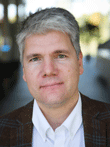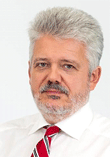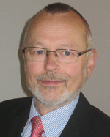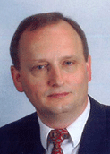|
Components |
|
 |
SiC components
Peter Friedrichs, Infineon Technologies AG, Erlangen, Germany |
|
SiC power diodes are seen today after 15 years of commercial availability as an established component in high end applications targeting to best efficiency or highest power density. The worldwide sales increased continuously, in several applications like server PFC or booster stages in solar inverters they are meanwhile an integral part of new designs. Majority
of the products are still discrete 650V devices, complemented by 1200V parts in discrete packages, but also a growing part of SiC diodes in power modules. The presentation will sketch the current technological benchmark for diodes and give an outlook in future potentials Transistors are commercially available since 2012, the core area here are 1200V based switches in various forms like MOSFETs, Bipolar transistors (BJT) or JFETs. Those new devices offer significant system advantages, but they also need more design efforts in order to use the features in a beneficial way. The variety of solutions seems to be confusing in the beginning for a large number of users, discussions about immaturities are frequently observed and thus, more efforts need to be spend in order to increase the attractiveness of SiC switches.
Interesting will be the outlook towards very high voltage components based on SiC. Demonstrations are numerous, the potential clearly visible. Future work will show whether the components can bring added value at system level and how the single chip solutions can be positioned vs. series connected devices resp. multilevel topologies. |
|
|
 |
GaN for industrial applications
Radoslava Mitova, Schneider-Electric |
| Dr. Radoslava Mitova received her diploma in Electrical Engineering from Technical University of Sofia in 2001. She received her Ph.D degree in Power electronics from the National Polytechnic Institute of Grenoble, France in 2005. She also worked for PRIMES lab (Tarbes) on high voltage multilevel power converter architectures with medium voltage transformer for railway traction. She joined Schneider Electric in 2007 as Power Electronics engineer. She works on SiC and GaN based power devices semiconductors application in industrial inverter. Her research interests further include condition monitoring and predictive diagnostic on power converters. |
|
 |
Design and Materials of Antiferroelectric Capacitors for High Density Power Electronic Applications
Günter Engel, Dr. Engel CeraCap Technology & Innovation Consulting, Austria |
|
Dr. Engel: Currently working as senior consultant at CeraCap Technology & Innovation Consulting, in Leibnitz, Austria.
Academic education 1978 - 1985 in physics and technical sciences at the Graz University of Technology, Austria.
Professional career until 1990 as a research-group team leader, AVL Graz - Austria, main interest in piezoelectric crystals.
Until 2013, working as a director of multilayer ceramic technology development at Siemens - Matsushita, later Epcos, then TDK, in Deutschlandsberg - Austria, since 2013 working as an independent consultant in the fields of capacitors, ceramic multilayer, passive electronic components, mainly for applications in power electronics. |
|
| General aspects of packaging |
 |
Photovoltaic Inverters in µ-Scale
Regine Mallwitz, Technische Universität Braunschweig, Germany |
|
Prof. Dr. Regine Mallwitz studied electrical engineering and received the Dipl.-Ing. degree at the “Otto-von-Guericke” University Magdeburg in 1994. After working on pulse power problems in gas and solid lasers at LAMBDA PHYSIK GmbH (today: Coherent) Goettingen and LISA Laser Products OHG Lindau, Germany, she received the PhD degree in 1999 at the University of Kassel. 1999 she entered the company eupec GmbH Warstein (today: Infineon) as R&D engineer and was responsible for the development of 1700V IGBT module family until 2004. From 2005 to 2013 she was with SMA Solar Technology AG. In 2013 she was appointed professor for Renewable Energies and Electromobility at University of Applied Sciences Fulda responsible. Since 2014 she is professor of Power Electronics at TU Braunschweig. Her special scientific interests are the application of fast switching power semiconductors and their integration of power electronic devices for instance photovoltaic inverters. |
|
| Packaging types |
 |
Investigation of a power module with double sided cooling using a new concept for chip embedding
DI Hannes Stahr, AT&S AG , Austria Technologie & Systemtechnik Aktiengesellschaft , Leoben, Austria |
|
• He studied electronics and telecommunication engineering at the University in Graz and received his diploma in 1988
• He works as a group manager technology in the R&D of AT&S and was deeply involved in the most recent developments for HDI PCB
• Since 1997 his focus area is component embedding in PCB staring with printed passive components
• In 2008 he guided the FP7 project Hermes to success which resulted in the industrialization of the chip embedding technology und later to the foundation of the business unit Advanced Packaging in AT&S
• He is author and co-author in 21 filed patent families for PCB and advanced packaging |
|
H. Stahr, M. Morianz, AT&S, Leoben, Austria
S. Gross, Continental, Nürnberg, Germany
Michael Unger, Johann Nicolics, TU Wien, Austria
Embedded components technology has launched its implementation in volume products demanding for highest miniaturization level. Small modules with embedded dies and passive components on the top side are mounted in handheld devices. Smart phones have been the enablers for this new technology using the capabilities of embedded components. With this technological background another business field became interesting for embedded components – the embedded power electronics. These applications ask for quite different requirements compared to the embedded technology of the first generation. The roadmaps for power application development show an ongoing decrease of volume and weight for power modules driven by the requirements for automotive industry.
The European project EmPower1) has been labeled from CATRENE (Cluster for Application and Technology Research in Europe on NanoElectronics) organization and launched in 2013 as a development project for new power packages and power modules using die embedding technology. For the realization of this technology copper termination on MOSFETs, IGBTs and power diodes is necessary. Equipment and processes have been developed in the supply chain of EmPower to support the development of power modules ranging from 500 W to 50 kW. For enhanced thermal performance of power modules a concept for double sided cooling has been developed. Besides full area contacting the MOSFET on drain side with copper and contacting the embedded components in a power core with an isolated metal substrate with silver sinter paste a very effective concept for reducing thermal resistances and inductance will be shown on the example of a 500W demonstrator. With the realization of this demonstrator the power embedding concept can be proved. This paper will focus on the behavior of the power module for operational conditions of a pedelec2) application. Basic reliability aspects will be shown as well as the electrical characterization – switching behavior, power losses and power cycling. Furthermore the thermal properties of the 500W demonstrator module as predicted by results from thermal simulations will be experimentally verified. Finally an outlook will be given for possible automotive products based on this Demonstrator. |
|
| Systems and applications |
 |
Challenges in low-voltage high-current applications - fathom the limits in system design
Ulf Schwalbe, Technische Universität Ilmenau, Germany |
Dr.- Ing. Ulf Schwalbe received the diploma in electrical engineering from the TU Ilmenau in 2004. He did his Ph.D. thesis at the TU Ilmenau in 2009 in cooperation with Infineon AG and ISLE GmbH. In the period 2008 to 2012 Dr. Schwalbe was project manager for power electronics systems design at ISLE. Since this time he is also responsible for the apprenticeship of power supplies at Technische Universität Ilmenau. From 2012 to 2014 Dr.
Schwalbe was the leader of the electric-mobility research team at the “Thuringian Center of Innovation in Mobility”. Since 2015 Dr. Schwalbe is responsible for the business development at ISLE GmbH. |
The system design in power electronics is driven by increasing the utilisation level of the used components to get a gain in performance at a constant cost level. This contribution gives an overview about different challenges in low-voltage high-current systems, e.g. used in automotive applications. The main content points are: topology selection – single Systems vs. cascaded systems, PCB manufacturing technology overview, current measurement methods, bulk capacitor design (ceramic DC link) and PCB design instructions for high current systems. The PCB design instructions target on optimised thermal design for
maximised PCB utilisation and on optimised track design for a low inductance DC link interconnection. The paper based on calculations, measurements and simulations. |
|
|

|
1-MW Solar Power Conditioning System with Boost Converter using all-SiC Power Module
Dr. Kansuke Fujii, Fuji Electric Co., Ltd., Japan |
|
Dr. Kansuke Fujii received the Bachelor and the Master of Electrical Engineering degree from Tokyo Institute of Technology, Tokyo, Japan, in 1995 and 1997, respectively. In addition, he received Dr. of Engineering degree from RWTH Aachen University, Germany, in 2008. Since 1997, he has been working for Fuji Electric Co., Ltd., Tokyo, Japan. He is a member of IEEE, and a senior member of IEEJ. His interests include control and circuit topology of medium voltage converters. He has won the Conference Best Paper Award of PESC in 2004 and PCIM Asia in 2012. |
|
| Reliability |
| Clean switching, EMC |
 |
Parasitic inductance hindering utilization of power devices
Reinhold Bayerer, Infineon Technologies AG
|
|
Reinhold Bayerer studied physics at the Technical University of Darmstadt, Germany and completed in 1979. He continued at this University as Research Associate and achieved his doctor’s degree in physics in 1985.
He works in the field of IGBT Modules since then. A first paper on early IGBT-modules was given at PCI, Munich, 1987. He contributed to the fields of packaging technology, low inductance module design, test and application engineering, driver electronics, as well as manufacturing engineering. Several publications and patents may serve as a reference. Today, he is Fellow for physics of power modules and working at Infineon Technologies in Warstein, Germany. |
|
 |
New Gate Driver Solutions for Modern Power Devices and Topologies
Reinhard Herzer, SEMIKRON Elektronik GmbH & Co KG, Germany |
|
Reinhard Herzer studied Electrical Engineering and received 1984 his PhD in the field of Microelectronics and 1992 his Habilitation in the field of Power Devices and Smart Power ICs from the Ilmenau Technical University. He joined Semikron Electronics Nuremberg, Germany in 1995 as head of the MOSFET, IGBT and IC research department. Now he is responsible for the application of new power device as well as the development and introduction of driver- and sensor- IC in new power modules and Systems.
Further he is Associated Professor at the Technical University of Ilmenau were he teaches and coaches students and PhD students. |